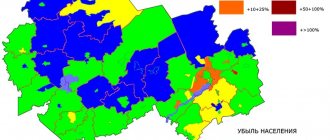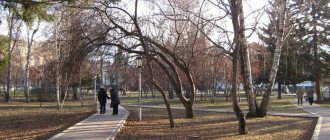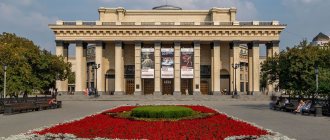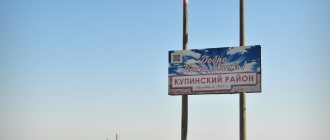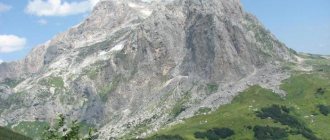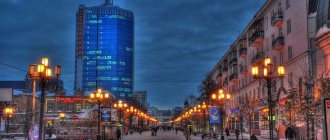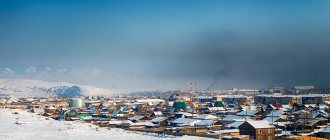List of settlements
In Altai, where the borders of 4 countries at once - Russia, Mongolia, the Republic of Kazakhstan and the People's Republic of China - meet, and the Biya meets the Katun to create a deep river, stands the second largest and most important city in the region.
It grew out of a small fortress built at the behest of Peter I. In Biysk, where 200 thousand people live , modern neighborhoods alternate with ancient buildings, a scientific center has been opened, and industrial enterprises operate.
Upstream, surrounded by the Ob on one side and pine forest on the other, is the largest city in Altai. Barnaul, which arose as a village for workers of a silver processing plant, includes 5 districts where 630 thousand people live.
North of the regional center in the lower reaches of the Oka tributary is Novoaltaisk , the northern part of which is built up with one-story houses, while high-rise buildings and industrial enterprises are concentrated in the southern part. The city, which is a major railway junction, has about 70 thousand inhabitants.
During the war, enterprises and institutions were evacuated to the village, founded in the 18th century, 200 km from Barnaul, which contributed to the development and acquisition of city status. In Kamen-na-Oka, the river forms picturesque islands, including Bolshoy Sobachy, which is constantly changing in size.
Further, the water artery passes through the Novosibirsk region and flows through the largest city in the Asian part of the country, the number of residents of which exceeds 1.6 million people.
For 500 km from the regional center there is not a single large settlement until the ancient town of Kolpashevo, lost among swampy terrain and forests and surprising with 2-story five-walled buildings that are 100 years old.
Passing Strezhevoy, founded by settlers from the southern regions of Siberia, the great river leaves the Tomsk region and heads to the Khanty-Mansiysk Okrug, where it meets on the way:
- Nizhnevartovsk;
- Langepas;
- Megion;
- Surgut.
Beyond the downstream Nefteyugansk Oka, bypassing the inaccessible and deserted territory, it reaches the Yamalo-Nenets District and forms a huge lip before flowing into the sea. Here, in the subarctic zone, stands Salekhard, which grew up on the site of a fortress founded by the Cossacks in the 16th century .
Labytnangi is located north of the Arctic Circle on the eastern slope of the Urals. In the summer, the city with a population of 26 thousand is connected with Salekhard by ferry; after navigation is closed, the center of the district along the Ob is reached by all-terrain vehicles or by air by helicopter.
Add creativity to interior design and decor
In the OBI online store and hypermarkets you can choose new wallpaper, update kitchen furniture, shower or bathtub, home textiles, or find accessories to your taste that will make the interior more comfortable. Showrooms in the kitchens, decorative tiles and sanitary ware departments will help you find inspiration for changes, tell you how to use current trends in interior design, and introduce you to the most interesting materials in our range.
- • Do you lack professional advice to implement your plans? In the World of Useful Tips OBI section, we have collected many creative solutions and step-by-step instructions. This is a real repair encyclopedia in which you will find useful tips and interesting ideas.
- • Register on the website DIY.obi.ru, communicate, exchange opinions, share your own experience, ask questions. Useful functionality on the site can help bring your project to life.
- • Come to master classes at OBI hypermarkets. You will learn how to properly lay laminate and tiles, apply plaster and paint, mix dry mortar and glue wallpaper. In the “Garden Paradise” department, OBI employees will give advice on choosing plants and seeds, recommendations for caring for a summer cottage
Construction hypermarket OBI wishes you a pleasant shopping experience! We work to make your life more comfortable. If you have questions about the product range or services, please contact the hotline by phone.
List of major metropolitan areas located on the banks
In Novosibirsk, which is famous for its museums and architecture, there are defense enterprises, metallurgical companies, and machine-building plants that produce turbogenerators for power plants built in different countries of the world.
Produced here:
- nuclear fuel;
- sheet metal;
- pipes and profiles;
- aviation complexes.
Novosibirsk supplies sights, telescopes, thermal imagers for the Russian army, produces equipment for oil and gas wells, provides the city with stoves for tram crossings, and residents with clean bottled water and food.
Barnaul, which attracts tourists with its green parks, picturesque embankment, and merchant mansions, is significantly behind Novosibirsk in terms of the number of industrial enterprises.
The city's factories produce:
- motors,
- machines,
- railway carriages,
- building materials,
- coke,
- products.
Investments are made in Barnaul:
- in the tourism industry;
- in agriculture;
- city infrastructure.
The development of Surgut, where 330 thousand people live, is associated with the discovery of new oil and gas fields. The city's industry was created around the production and transportation of hydrocarbons.
The thermal power plant built on the Oka uses local fuel and supplies energy to the Ural District. Surgut enterprises process timber and produce building materials and food products for the needs of the city.
Nizhnevartovsk, next to which the Samotlor field is located, from where the Soviet Union extracted a third of all oil , was included in the list of the richest cities in Russia.
In recent years, many new buildings have been erected here, enterprises producing food, instruments, and a fish processing plant have been put into operation, but 80% of the city’s industry is hydrocarbon production.
Salekhard is the only capital of the district and a city that arose on the Arctic Circle . It lags significantly behind Surgut, Nizhnevartovsk, and Barnaul in terms of area, population and development. The former regional village lies among endless tundra, and can be reached by ferry or plane.
Despite the harsh climate, the absence of highways and railways, construction materials, wooden parts, and gold are mined in Salekhard.
What is a sorting center?
Russian Post and other delivery services are successfully used by online stores. When ordering, goods from the store warehouse are transferred to the service, where they are packaged and loaded onto vehicles. Often cars have to travel hundreds of kilometers before they reach the desired post office and deliver letters and parcels. Sorting centers were created as transfer stations. They process correspondence and transfer the information to a database where it is available for tracking queries.
A sorting center is a semi-mechanized workshop in which parcels and parcels are processed by machines and people. Each shipment will be inspected for damage or deformation. The data from the accompanying sheet is entered into the computer by the operator. The correspondence is again sorted and packaged for further transportation. At the point, she is picked up by the next flight of cars that are heading along the designated route.
Excerpt characterizing Ob (city)
Noticing the unpleasant impression this technique produced on Balashev’s face, Davout raised his head and coldly asked what he needed. Assuming that such a reception could be given to him only because Davout does not know that he is the adjutant general of Emperor Alexander and even his representative before Napoleon, Balashev hastened to announce his rank and appointment. Contrary to his expectations, Davout, after listening to Balashev, became even more severe and rude. - Where is your package? - he said. – Donnez le moi, ije l'enverrai a l'Empereur. [Give it to me, I will send it to the emperor.] Balashev said that he had orders to personally deliver the package to the emperor himself. “The orders of your emperor are carried out in your army, but here,” said Davout, “you must do what you are told.” And as if in order to make the Russian general even more aware of his dependence on brute force, Davout sent the adjutant for the duty officer. Balashev took out the package containing the sovereign’s letter and placed it on the table (a table consisting of a door with torn hinges sticking out, placed on two barrels). Davout took the envelope and read the inscription. “You have absolutely the right to show or not show me respect,” said Balashev. “But let me note that I have the honor to bear the rank of His Majesty’s Adjutant General...” Davout looked at him silently, and some excitement and embarrassment expressed on Balashev’s face apparently gave him pleasure. “You will be given your due,” he said and, putting the envelope in his pocket, he left the barn. A minute later, the Marshal's adjutant, Mr. de Castres, entered and led Balashev into the room prepared for him. Balashev dined that day with the marshal in the same barn, on the same board on barrels. The next day, Davout left early in the morning and, inviting Balashev to his place, impressively told him that he asked him to stay here, move along with the luggage if they had orders to do so, and not talk to anyone except Mister de Castro. After four days of solitude, boredom, a sense of subordination and insignificance, especially palpable after the environment of power in which he had so recently found himself, after several marches along with the marshal’s luggage, with the French troops occupying the entire area, Balashev was brought to Vilna, now occupied by the French , to the same outpost where he left four days ago. The next day, the imperial chamberlain, monsieur de Turenne, came to Balashev and conveyed to him the desire of Emperor Napoleon to honor him with an audience. Four days ago, at the house to which Balashev was taken, there were sentries of the Preobrazhensky Regiment, but now there were two French grenadiers in blue uniforms open on their chests and in shaggy hats, a convoy of hussars and lancers and a brilliant retinue of adjutants, pages and generals waiting to leave Napoleon around a riding horse standing at the porch and his Mameluke Rustav. Napoleon received Balashev in the very house in Vilva from which Alexander sent him. Despite Balashev's habit of court solemnity, the luxury and pomp of Emperor Napoleon's court amazed him. Count Turen led him into a large reception room, where many generals, chamberlains and Polish magnates were waiting, many of whom Balashev had seen at the court of the Russian emperor. Duroc said that Emperor Napoleon would receive the Russian general before his walk. After several minutes of waiting, the chamberlain on duty came out into the large reception room and, bowing politely to Balashev, invited him to follow him. Balashev entered a small reception room, from which there was one door to an office, the very office from which the Russian emperor sent him. Balashev stood there for about two minutes, waiting. Hasty steps were heard outside the door. Both halves of the door quickly opened, the chamberlain who opened it stopped respectfully, waiting, everything became quiet, and other, firm, decisive steps sounded from the office: it was Napoleon. He had just finished his riding toilet. He was wearing a blue uniform, open over a white vest that hung down over his round belly, white leggings that hugged the fat thighs of his short legs, and boots. His short hair had obviously just been combed, but one strand of hair hung down over the middle of his wide forehead. His white, plump neck protruded sharply from behind the black collar of his uniform; he smelled of cologne. On his youthful, plump face with a prominent chin there was an expression of gracious and majestic imperial greeting.
Information about the sorting center
Data on the geographic location of the sorting center is stored on information reference portals such as My Parcel and others. If you need to find out about a specific mechanized correspondence processing workshop, use the search bar on this site. Enter the identification number in the verification field or use the city name of the SC.
They can also be found through web maps by writing in the search bar the name of the locality where the sorting center is located. In addition to the index and general telephone number of the Russian Post, the user will have the opportunity to find out the exact address of the location of the building.
